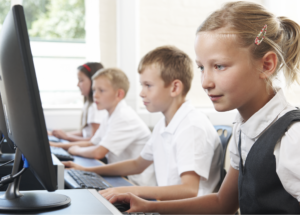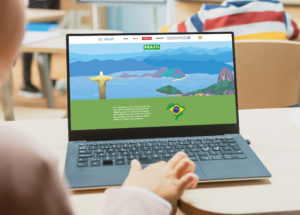Building Pupil Motivation Through Curiosity and Self-Confidence
Michelle D. Ravenscroft - Educator
“We keep moving forward, opening new doors, and doing new things because we’re curious and curiosity keeps leading us down new paths.”
– Walt Disney.
Learning Through Discovery Improves Student Self-Esteem
 Young children are naturally inclined to explore, and by providing a safe and secure environment, along with opportunities for discovery, we can encourage their innate curiosity about the world. This motivation enables the development of ability, creating a sense of personal achievement. This sense of personal development and achievement also increases personal awareness and self-esteem.
Young children are naturally inclined to explore, and by providing a safe and secure environment, along with opportunities for discovery, we can encourage their innate curiosity about the world. This motivation enables the development of ability, creating a sense of personal achievement. This sense of personal development and achievement also increases personal awareness and self-esteem.
Bartlett and Burton argue that ‘[1] Healthy self-esteem is fundamental both to learners’ academic performance and to their emotional wellbeing since it affects motivation’. Motivation is self-determined, yet it is increasingly understood that as pupils progress through their education, the motivation to learn can be dependent on many factors.
‘[2] Cook and Artino argue that ‘motivation … often involves interactions between an individual and a larger social context’. In addition, the continuation of a curious and enquiring mindset can be influenced by the perceived necessity to meet both academic and peer-group expectations.
Developing Key Inquiry Skills – Forest School
Continued access to inquiry-based discovery learning opportunities is crucial to enable the development of positive character traits, such as curiosity and self-confidence. Therefore, an exploratory approach can provide the opportunities for pupils to become independent, curious, self-confident learners; and develop their abilities, and self-determination to achieve for themselves.
As pupils progress, they need to have an awareness of the character traits that will enable independent learning and achievement. This can be achieved both in the classroom and through outdoor learning. A leading Forest School training provider suggests that ‘[3] The ethos of Forest School is based on a fundamental respect for children and young people, and for their capacity to instigate, test and maintain curiosity in the world around them.’ Forest School sessions give pupils the opportunity to develop both self-awareness and self-confidence through independent enquiry. The provision of learning activities that encourage controlled risk-taking, such as tree-climbing, den-building and camp-fire cookery, fosters curiosity whilst enabling the development of new and existing skills.’
Adult and peer role-models also play a crucial part in encouraging self-development and building self-confidence. Forest School activities require the adult to adopt a different approach to that often assumed in the classroom. The adult removes the modelling process completely and takes a step back to become a delegator. Delegators offer minimal direction, enabling the pupils to access the learning opportunities whilst encouraging pupil autonomy and independence (4. Grasha, 1996, p. 154). As pupils participate, they progress by developing their self-confidence in their own abilities and skills; a very powerful motivator to learn.
Motivational Peer Role-Models
As the activities accessed by the pupils require an increasing amount of independence, so do the role-models that encourage this behaviour. Role-models that display positive character traits, such as high self-esteem and self-confidence, can influence pupils by encouraging independent inquiry. Peer-group models have shown to have a powerful impact on pupil motivation. Providing the opportunity for this influence to shape pupils’ learning, should continue throughout the learning journey.
Tim Murphey, 1998, outlines the importance of peer influence: ‘[5] Knowing the content, is only one aspect of effective teaching. Perhaps even more valuable, is knowing how to create generative learning structures {opportunities that allow the active integration of new ideas with the learner’s existing knowledge} that allow for quality interaction in which students can learn from and inspire each other. Structuring classroom experiences to enhance near peer role modelling [sic] may be one of the most powerful ways teachers can enhance learning’.
Whilst learning in the Forest School area, pupils discuss tasks increasingly with their peers, and the prior experience of some group members encourages exploration and development of skills. However, examples of peer-models that display the positive character traits of self-confidence and curiosity are still necessary to provide encouragement to even the most confident and curious of pupils.
Can Do Kids Worldwide – A Case Study
 In addition to classmate exemplars, how do we provide examples of curious, self-confident, motivated peer-models? This was a question posed prior to a recent Forest School session with a year 3 class (ages 7-8). The topic for the half-term was Brazil. The pupils had participated in some sessions in the classroom relating to the topic, and this was extended to link their learning to a Forest School session that focused on exploring the area and building confidence.
In addition to classmate exemplars, how do we provide examples of curious, self-confident, motivated peer-models? This was a question posed prior to a recent Forest School session with a year 3 class (ages 7-8). The topic for the half-term was Brazil. The pupils had participated in some sessions in the classroom relating to the topic, and this was extended to link their learning to a Forest School session that focused on exploring the area and building confidence.
It was expected that some of the pupils would be hesitant when moving around the area, as the weather had been extremely wet in the days prior to the session. They were encouraged to explore, whilst using the area safely. This was achieved by introducing a hazard perception task, where the pupils worked in small groups to identify any possible hazards and explain to the class how these could be negotiated safely. However, prior to beginning the session, the pupils were motivated to do this.
Virtual Field Trip Using Can Do Kids Worldwide As Peer Role Models
To achieve our aim, we watched a Can Do Kids Worldwide video, where a group of children who have formed a virtual band travel around the world exploring, discussing and singing about the geographical, historical and cultural aspects of the different countries that they visit.
To link in with our topic, we chose the Can Do Kids Visit Brazil resource, aimed at children from ages 7-9. The 5-minute long clip showed pictures and videos of Brazilian life and locations, to the soundtrack of the band singing an informative and energetic song in the Brazilian style. The pupils immediately engaged with the resource, enjoying the ‘cool’ music, and commenting on the name of the band. The song includes the line ‘We are the Can Do Kids Band, we can fly to any land’, inferring curiosity and confidence. The characters’ reference to their ability to go anywhere was not lost on the pupils, with one stating ‘They are the Can Do Kids, they can do things!’, to which it was replied, ‘Yes, they can do things, and so can you!’.
This immediately indicated that the children were identifying with the role-models. The characters in the video provided motivated, curious and self-confident peer role-models through their positive and inquisitive outlook. Their ability to visit any country and experience the exciting cultural aspects encouraged the pupils to go out and explore the Forest School area with a Can Do attitude and an awareness of their surroundings. So much so, that the following week, again during Forest School, one group of children chose to design a Brazilian flag depicting themselves as Can Do Kids characters. This supports the argument for the lasting influence of positive peer role-models. It also underpins the importance of the power of both identifying with others and of positive self-identification.
Extended Educational Opportunities With Interactive Learning Tools
The Can Do Kids Worldwide resources are developed to encourage the awareness of cultural diversity, yet can easily form part of a session with a focus on Character Education. Therefore, they lend themselves to a variety of cross-curricular projects in classes such as social studies, geography, as well as offering a diverse range of activities that support literacy and oracy skills development also. Both the name of the band and their confident attitude were inspirational to the pupils, and the resources could be used as the basis for further discussion and extension activities prior to a session where pupil motivation or self-confidence was low. As well as remembering the names of the band members, pupils also connected with the song, which supports the understanding that positive peer influence, in any shape or form, can be extremely effective.
As educators, we have a responsibility to provide resources that inspire, motivate, and build confidence in their pupils. Furthermore, those resources must be relevant and fit for purpose. The Can Do Kids Worldwide resources provide relatable peer role-models that encourage exploration and curiosity about the world. Such a resource can provide both the structure and motivation to actively engage learners, whilst simultaneously developing their ability to question, explore and grow in confidence.
– REFERENCES –
- Bartlett, S. & Burton, D. (2012), Introduction to education studies (3rd ed.). London, United Kingdom, Paul Chapman Publishing.
- Cook, D. A. & Artino, A. R. (2016), Motivation to learn: an overview of contemporary theories. In Medical Education Journal. 50(10), 997-1014. Retrieved from https://onlinelibrary.wiley.com/doi/full/10.1111/medu.13074
- Forest School Training Company (N.D.) Retrieved from https://www.forestschooltraining.co.uk/ethos/
- Grasha, A. (1996), Teaching with style. Pittsburgh, Pennsylvania, Alliance Publishers.
- Murphey, T. (1998), Motivating with near peer role models. In Brad Visgatis (Ed.), On JALT 97: Trends and Transitions. 201-205. Retrieved from http://jalt-publications.org/archive/proceedings/previous/jalt97.pdf#page=209




